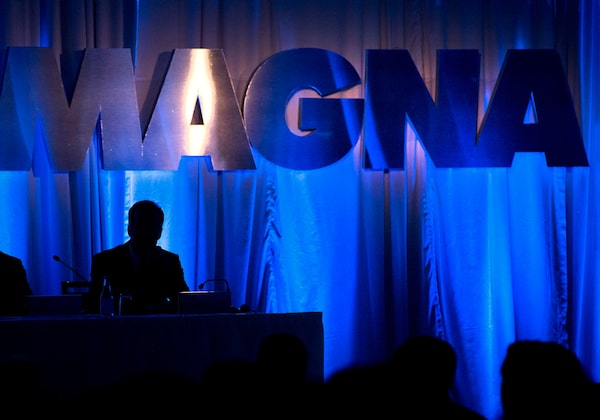
The company blamed the stronger U.S. dollar, the sale of its fluid pressure and controls business, and estimated lower light-vehicle production in Europe for its lower sales outlook.Nathan Denette/The Canadian Press
Auto parts maker Magna International Inc. has promoted technology chief Swamy Kotagiri to president, signalling that the engineer who has overseen some of Magna’s most advanced projects could be the next occupant of the chief executive officer’s role.
Aurora, Ont.-based Magna made the announcement of Mr. Kotagiri’s promotion on Thursday morning as it issued a forecast for the coming three years.
Magna forecast lower 2020 sales and scrapped its partnership with ride-hailing firm Lyft Inc. to co-develop self-driving technology as it said it would instead focus on developing assisted-driving technology.
The company blamed the stronger U.S. dollar, the sale of its fluid pressure and controls business, and estimated lower light-vehicle production in Europe for its lower sales outlook.
Mr. Kotagiri, who was educated in India and the United States, has been with Magna since 1999, and previously worked at General Motors.
Magna said Mr. Kotagiri will work with CEO Don Walker on Magna’s overall strategy, research and development initiatives and new projects. He will continue to be responsible for the power and vision division, a segment that includes automated driving, electric and hybrid drivetrains and electronics systems.
On his LinkedIn website profile, Mr. Kotagiri says he moved to the U.S. from India in 1993 to study mechanical engineering at Oklahoma State University. “I still remember arriving in the U.S. with $40 cash in my pocket, enough money to cover my first semester’s tuition and the bag on my back,” he wrote.
Peter Sklar, a stock analyst at Bank of Montreal, said Mr. Kotagiri’s appointment suggests he is a strong candidate to replace Mr. Walker as CEO within the next five years.
The end of the partnership with Lyft to develop self-driving technology was driven by Magna’s belief that growth in the near and medium term – out to 2025 – is more in the driver-assisted market, called the L1, L2 and L3 market, Mr. Kotagiri said.
Mark Neville, a Bank of Nova Scotia analyst, said the end of the Lyft partnership should not be seen as Magna scaling back its spending on autonomous systems, but a refocusing, given the rise in investment in driver-assisted systems. “Given uncertainty around the penetration rates of autonomous vehicles, the level of competition in the space, uncertainty around technologies, etc., we view this is a prudent move by management,” he said.
While Magna will cease working with Lyft on developing self-driving technology, it will still collaborate with the company on various software and hardware programs, Mr. Kotagiri said. Magna invested US$200-million in Lyft in 2018 to manufacture self-driving cars.
Magna said its 2020 operating margins would improve due to lower spending on developing assisted and autonomous technology as well as the end of the Lyft-related spending.
Mr. Kotagiri said, excluding Lyft, the company’s spending on developing technologies for autonomous and electric vehicles is rising.
Mr. Walker said on a conference call with analysts that the auto sector has become “more realistic” about how fast various autonomous technologies will penetrate.
Itay Michaeli, a Citi Research stock analyst, said Magna’s outlook is “solid” and shows it can post modest revenue growth while expanding its margins.
Magna reports sales separately for its four divisions: body and exterior structures, power and vision, seating and complete vehicles.
For the body and structures division, by far Magna’s biggest, sales will be little changed in 2020 from 2019’s estimated US$16.2-billion to US$16.6-billion. By 2022, the division could see sales of US$17.5-billion to US$18.5-billlion, the company said.
The power and vision segment, which includes transmissions and cameras, sales will be flat, in a range of US$10.7-billion to US$11.3-billion. Driven by demand for automated driving systems, electronics and powertrain electrification, sales could rise by 5 per cent by 2022, Magna said.
Sales in the seating division could rise by 4 per cent to 8 per cent by 2022, boosted by SUV sales and the launch of BMW’s 1 Series and 2 Series models. Sales for 2020 will be US$5.7-billion to US$6.1-billion, Magna forecast.
Sales of Magna’s complete vehicles will fall by about 10 per cent in 2020, from 2019’s estimated range of US$6-billion to US$6.4-billion. Magna said sales will slip after the launch of all announced vehicle projects, including cars made for BMW, Jaguar and Toyota.
With files from Reuters
Your time is valuable. Have the Top Business Headlines newsletter conveniently delivered to your inbox in the morning or evening. Sign up today.